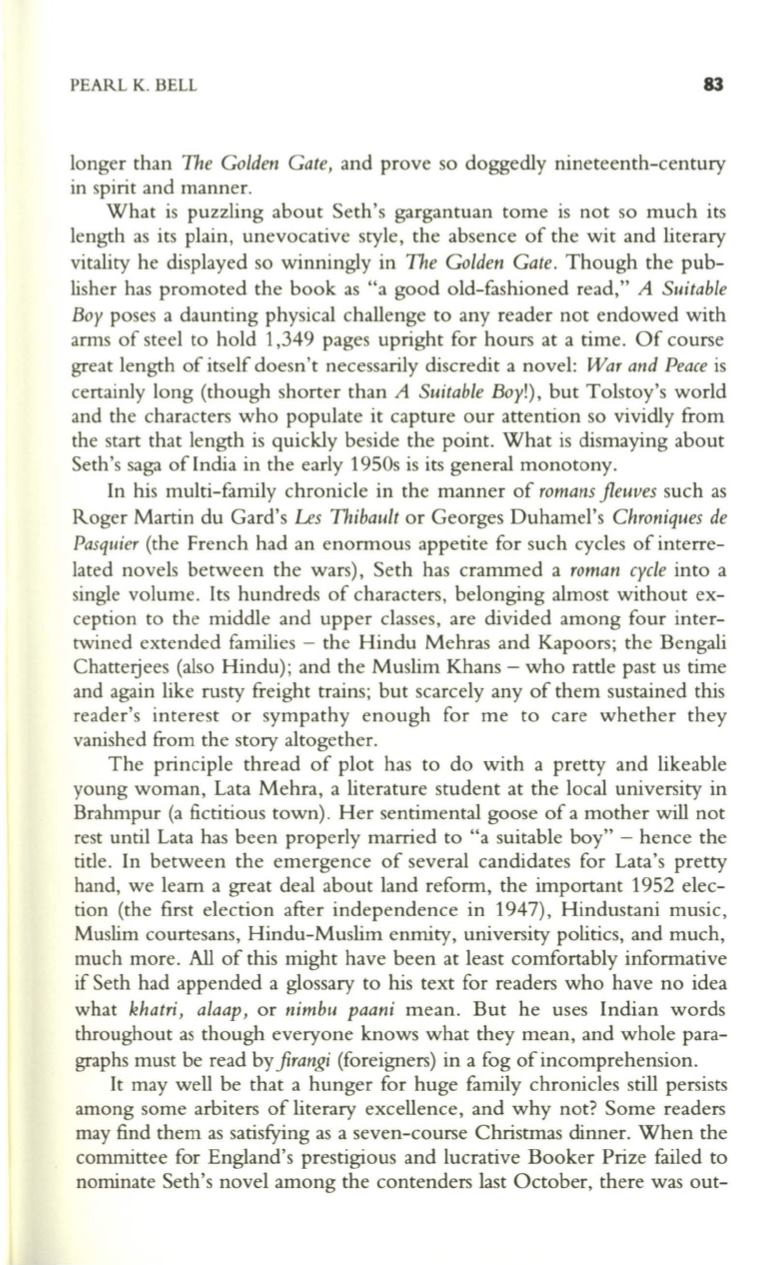
PEARL K. BELL
83
longer than
The Golden Gate,
and prove so doggedly nineteenth-century
in spirit and manner.
What is puzzling about Seth's gargantuan tome is not so much its
length as its plain, unevocative style, the absence of the wit and literary
vitality he displayed so winningly in
The Golden Gate.
Though the pub–
lisher has promoted the book as "a good old-fashioned read,"
A Suitable
Boy
poses a daunting physical challenge to any reader not endowed with
arms of steel to hold 1,349 pages upright for hours at a time. Of course
great length of itself doesn't necessarily discredit a novel:
War and Peace
is
certainly long (though shorter than
A Suitable Boy!),
but Tolstoy's world
and the characters who populate it capture our attention so vividly from
the start that length is quickly beside the point. What is dismaying about
Seth's saga of India in the early 1950s is its general monotony.
In his multi-family chronicle in the manner of
romans jleuves
such as
Roger Martin du Gard's
Les Thibault
or Georges Duhamel's
Chroniques de
Pasquier
(the French had an enormous appetite for such cycles of interre–
lated novels between the wars), Seth has crammed a
roman cycle
into a
single volume. Its hundreds of characters, belonging almost without ex–
ception to the middle and upper classes, are divided among four inter–
twined extended families - the Hindu Mehras and Kapoors; the Bengali
Chatteljees (also Hindu); and the Muslim Khans- who rattle past us time
and again like rusty freight trains; but scarcely any of them sustained this
reader's interest or sympathy enough for me to care whether they
vanished from the story altogether.
The principle thread of plot has to do with a pretty and likeable
young woman, Lata Mehra, a literature student at the local university in
Brahmpur (a fictitious town). Her sentimental goose of a mother will not
rest until Lata has been properly married to "a suitable boy" - hence the
title. In between the emergence of several candidates for Lata's pretty
hand, we learn a great deal about land reform, the important 1952 elec–
tion (the first election after independence in 1947), Hindustani music,
Muslim courtesans, Hindu-Muslim enmity, university politics, and much,
much more. All of this might have been at least comfortably informative
if Seth had appended a glossary to his text for readers who have no idea
what
khatri, alaap,
or
nimbu paani
mean. But he uses Indian words
throughout as though everyone knows what they mean, and whole para–
graphs must be read by
firangi
(foreigners) in a fog of incomprehension.
It may well be that a hunger for huge family chronicles still persists
among some arbiters of literary excellence, and why not? Some readers
may find them as satisfying as a seven-course Christmas dinner. When the
committee for England's prestigious and lucrative Booker Prize failed to
nominate Seth's novel among the contenders last October, there was out-


